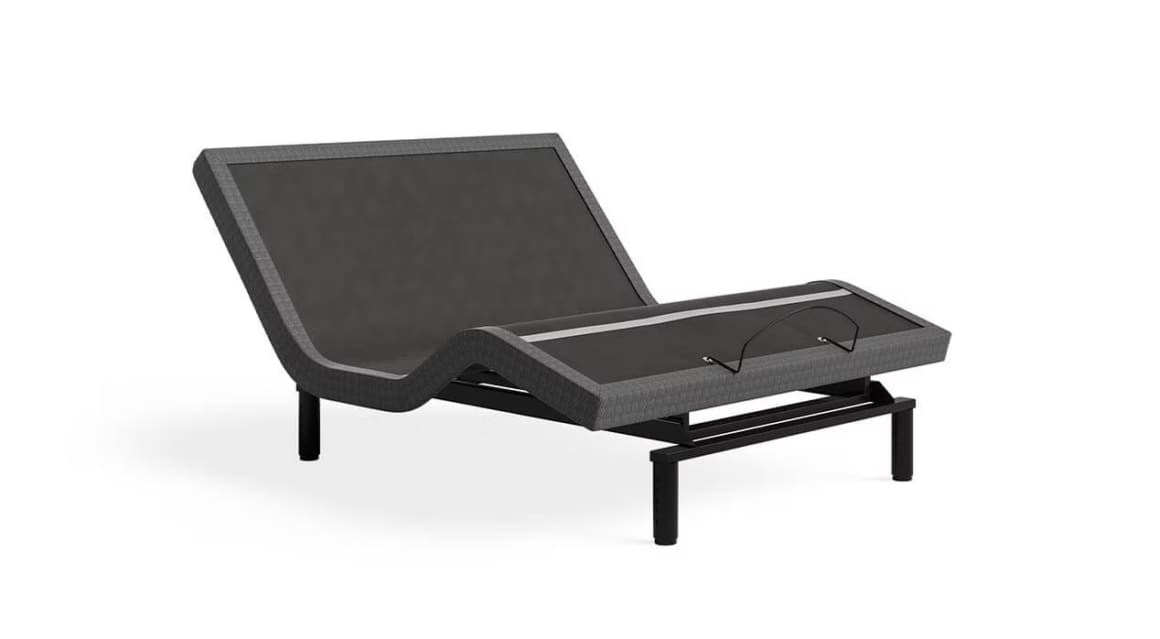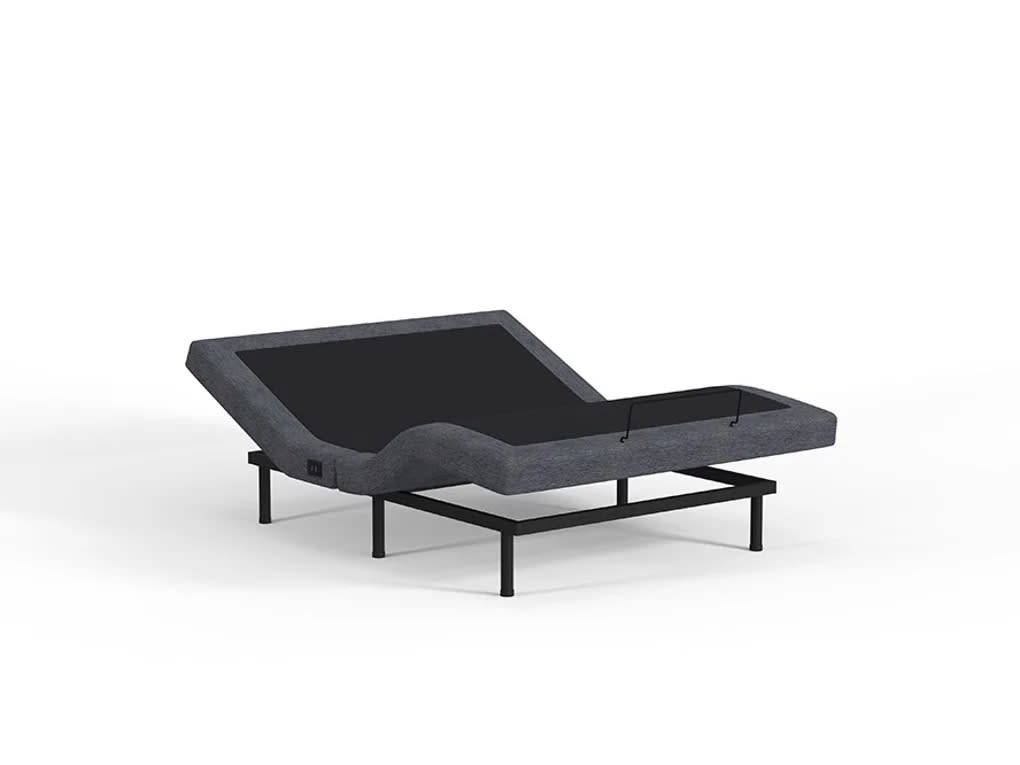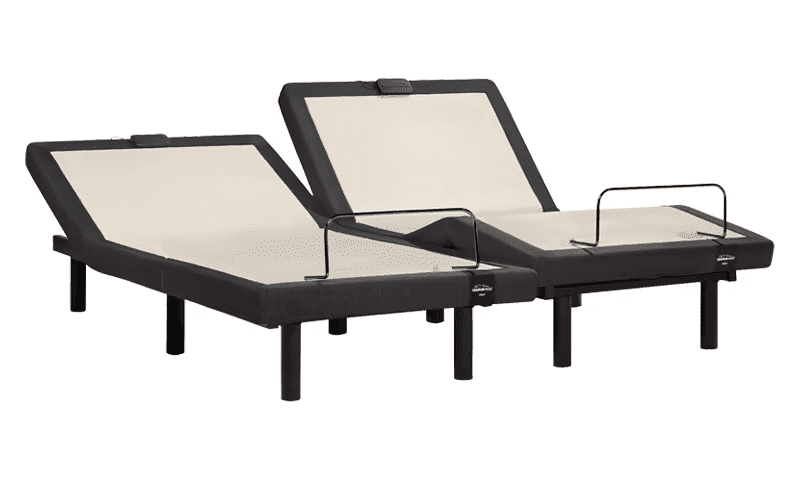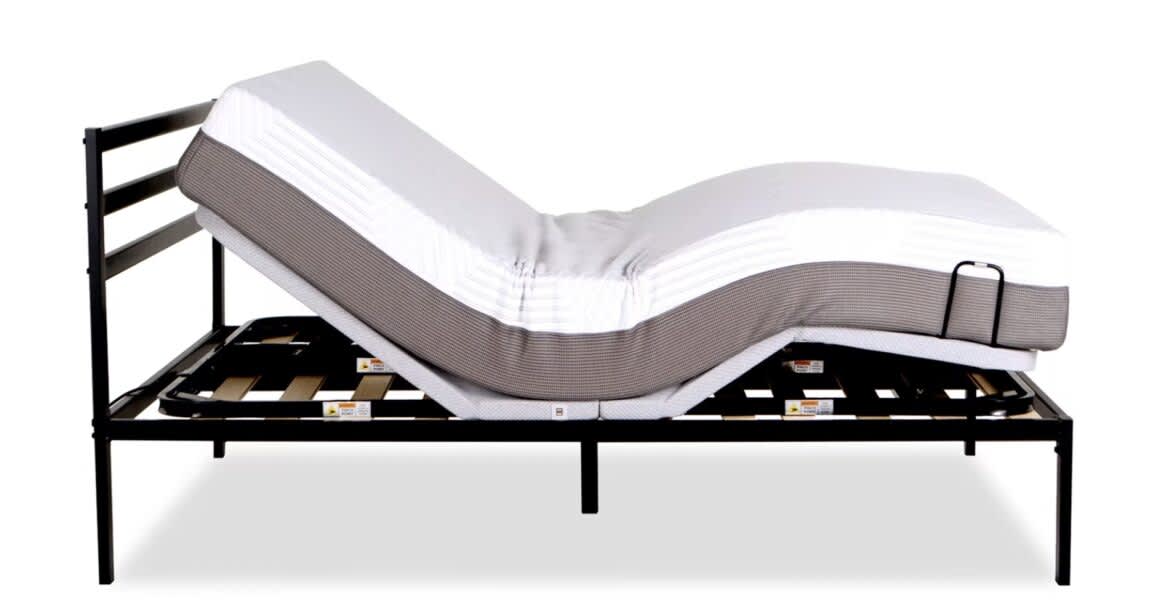On This Page
The Best Adjustable Beds of 2025
Our Top Picks
-
Best Overall
Saatva Adjustable Base Plus -
Most Versatile
Nectar Adjustable Bed Frame -
Best for Seniors
Dawn House Bed -
Most Innovative
Tempur-Pedic TEMPUR-Ergo Extend Smart Base -
Easiest Assembly
BedJet Adjustable Power Layer
Best Overall

With zero-gravity, massage, and wall-hugging technologies, the Saatva Adjustable Base Plus is one of the most versatile adjustable beds on the market. The base comes with a variety of features that you can control with a wireless remote. The remote also allows you to preset your favorite sleeping and relaxing positions.
Pros & Cons
Pros
- Many customizable features, including massage, zero gravity, and presets
- A quiet base with an above-average range of motion
- Free White Glove delivery
Cons
- Expensive price-point may deter budget-conscious shoppers
- No sleep trial, so no returns allowed
Our Take
Most Versatile

Nectar provides all of the most popular features with their Nectar Adjustable Bed Frame. The base includes all of the standard settings along with several premium features. This is a great option for sleepers who want a high-quality, durable adjustable bed with many premium features for a reasonable price.
Pros & Cons
Pros
- Dual-zone massage with multiple intensity settings
- Legs can be adjusted to three different heights
- All orders include a 50-night sleep trial
Cons
- Not available in twin or California king sizes
- Some customers report delivery issues
Our Take
Best for Seniors

Adjustable beds can be particularly beneficial to seniors who regularly wake up feeling sore or stiff. While any adjustable bed could potentially work for this population, we’re recommending the Dawn House Bed because of its sophisticated design and slew of senior-friendly features. If you’re looking for an adjustable base with a full suite of amenities, the Dawn House Bed might be worth the steep sticker price. Optional guard rails, voice controls, and health monitoring make the bed particularly well suited to senior sleepers.
Pros & Cons
Pros
- Senior-friendly design includes side rails, voice commands, and health monitoring
- Option to include an all-foam mattress with your purchase
- Free White Glove delivery with all orders
Cons
- Not sold in twin and California king sizes
- Very expensive compared to the competition
Our Take
Most Innovative

The Tempur-Pedic TEMPUR-Ergo Extend Smart Base includes some of the most high-tech features of any adjustable bed. While the inclusion of these features is reflected in the bed’s high price-point, this adjustable base is a good fit for any sleeper that wants a deluxe bed with a wide range of sleep settings.
Pros & Cons
Pros
- Built-in sleep tracker provides personalized sleep statistics
- Head automatically elevates when snoring is detected
- Zoned massage targets pressure points
Cons
- Returns not allowed
- Some owners report high levels of motion transfer
Our Take
Easiest Assembly

Most adjustable beds we recommend are freestanding foundations, but the BedJet Adjustable Power Layer is a bit different. This low-profile base can be placed on any existing foundation to transform it into an adjustable bed.
Pros & Cons
Pros
- Thin adjustable layer can be used with any bed frame
- Ultra-sturdy frame can support up to 900 pounds
- Add-ons available for freestanding legs, a headboard, and zoned massage
Cons
- Limited to four sizes with no twin, full, or Cali king options
- Sticker price is on the expensive side
Our Take
How We Test
We test every adjustable bed against the same set of criteria to make sure our choices are unbiased. We look closely at construction details and designs because they’re good indicators of both quality and durability.
We also try out the adjustable features to measure their noise levels and see how well they actually function. Our testing team members try each bed base to see how side, back, and stomach sleeping feel at the beds’ different adjustable settings.
Testers also take these bed bases home to see how compatible they are with different mattress constructions. Using the beds over several weeks also gives them a thorough understanding of how they perform in a real-world setting. Before we decide which models are the best, we look at verified customer reviews to learn what existing customers think of their adjustable beds.
What Is an Adjustable Bed?
Adjustable beds allow you to customize your sleep experience by raising or lowering the head and/or foot of the bed. An adjustable bed is a good fit for someone who wants to elevate their upper or lower body while in bed. This can include people with specific health concerns, like lower back pain or sleep apnea.
Adjustable beds often include other features beyond positional adjustments. Some adjustable beds include massage functions, built-in speakers, USB ports, and other smart functions. One feature that stands out is zero-gravity mode, where your legs and head are elevated higher than your heart. This can produce a weightless sensation akin to experiencing zero gravity.
Adjustable bed frames often come with a higher price-point than traditional bed frames, with a typical adjustable bed priced between $1,000 and $3,000. Not all mattresses are compatible with adjustable frames, and adjustable bed frames tend to be heavier than traditional bed frames.
Quick Pros and Cons of Adjustable Beds
Many sleepers could benefit from an adjustable bed, but weighing the pros and cons before making a purchase is essential. Those who snore may find relief by sleeping with their head elevated, and couples can benefit from split king or split queen adjustable beds that allow each sleeper to independently adjust their side of the bed.
One of the most obvious cons of an adjustable bed is the price-point, with these models costing considerably more than a traditional bed. However, some sleepers may find that making this investment is worth it for the sleep benefits. It’s also worth noting that adjustable beds are also much heavier than typical bases, and not all mattresses are compatible with every model.
Pros
- Customize your sleep experience based on needs and preferences
- May help with health concerns like acid reflux, swelling (known as edema), and sleep apnea
- Some settings can help relieve and snoring
Cons
- Above average price tag – usually between $1,000 and $3,000
- Much heavier than a traditional bed frame
- Your current mattress may not be compatible with an adjustable base
I can’t take a noisy bed, so it’s important to me that an adjustable bed is quiet when it moves up and down. If you’re the same, check manufacturer specs and reviews to see if a model is loud during adjustment.
Do Doctors Recommend Adjustable Beds?
A doctor may recommend an adjustable bed if you are living with certain health conditions. Sleeping with your head elevated may help alleviate some back pain or the symptoms of acid reflux and sleep apnea. If you snore, sleeping with your head elevated could lead to a quieter and less disruptive sleep for your bed partner. Those with limb swelling or arthritis may find that sleeping with their feet raised may relieve some symptoms.
Some insurance plans may cover some of the cost of an adjustable base. Some insurers require your doctor to prescribe it as a treatment for a specific health condition and others may require the adjustable base to be hospital grade. Check with your insurer to see if this is an option and what limitations apply in your unique situation.
| Health Conditions an Adjustable Bed May Help Alleviate |
|
|
Types of Adjustable Beds
Most adjustable beds come in twin XL, queen, and king sizes, though many are also available in California king, split queen, and split king sizes. A standard adjustable bed moves the entire mattress, while split models are designed for co-sleepers with different sleep preferences.
Adjustable Bed Size
Available adjustable bed sizes vary by retailer and model, but you’ll typically find adjustable beds in twin XL, queen, king, and California king sizes. You won’t often find twin-sized adjustable beds.
Because adjustable bases are usually heavier than standard foundations, some manufacturers divide them into two pieces for easier installation. For example, Tempur-Pedic splits their king size adjustable bed into two pieces horizontally, which makes the base less cumbersome to assemble and move.
Split King and Split Queen Sizes
Co-sleepers with different sleep preferences may find split king and split queen sizes a good fit. Split models divide the mattress in half vertically, allowing sleepers to adjust each side independently without affecting the other side.
Some retailers do not offer king size adjustable bases, and instead require you to purchase either two twin XL bases (which add up to equal the same surface area as a king size bed) or a split king base. To move the two bases in unison, you either attach the two bases with a sync cable or use the sync function on the bed’s remote control.
| Split Adjustable Bases | Mattress Dimensions |
| Split Queen |
Two Split Mattresses: 30” x 80” eachTotal: 60” x 80” |
| Split King |
Two Split Mattresses: 38” x 80” eachTotal: 76” x 80” |
| Split California King |
Two Split Mattresses: 36” x 84” eachTotal: 72” x 84” |
Mattresses for Adjustable Beds
An adjustable bed is most compatible with memory foam, latex, and hybrid mattresses. The construction of these mattresses makes them more likely to conform when positioned on an adjustable bed.
Memory foam is durable, and its contouring qualities provide the flexibility needed on an adjustable base. Latex is heavier than memory foam but still bends and flexes to conform to an adjustable base. Hybrid mattresses with pocketed coils provide airflow and enough give to make them well-suited for an adjustable base.
Using a compatible mattress ensures that the adjustable base won’t ruin your mattress and that you receive the intended benefits of the base. For example, mattresses that are too rigid without the conforming qualities mentioned above are not compatible with an adjustable base. These include most innerspring mattresses and mattresses that are very firm, as they are not able to bend sufficiently.
How to Choose the Best Adjustable Bed
While all adjustable beds come with body elevation settings, additional features come with a higher price tag. It’s important to consider your own sleep needs and budget when determining the best adjustable bed for you. You can also consider qualities like range of motion, weight, mattress compatibility, warranty, and sleep trial. As a good starting point, consider the best-selling adjustable beds.
What to Consider in an Adjustable Bed
- Range of Motion: Typically, an adjustable bed allows you to elevate your head and/or feet while resting. How high you can raise each end of the bed depends on the model, but this is generally up to 80 degrees for the head and up to 40 degrees for the feet.
- Desired Features: Premium features are available with some adjustable beds. Keep in mind that these features often include an added cost but are also convenient options that you’ll frequently use, making them worth the cost for some shoppers.
- Weight Capacity: Pay attention to how much an adjustable bed can accommodate and add up the weight of everyone who will sleep in the bed. In general, adjustable bases can support 650 to 900 pounds.
- Adjustable Bed Weight: Adjustable beds tend to be heavy, ranging from 140 to 280 pounds. This can make moving the bed a challenge, and the total weight of the base, mattress, and sleepers could take a toll on homes with older flooring.
- Bed Height: Adjustable beds may have a higher profile than traditional mattresses. Some models include adjustable height settings that allow you to customize the bed’s height.
- Noise: Because these beds include adjustable options, you may hear the bed motor or other mechanisms during adjustments. This could impact light sleepers, but many new adjustable bed models have features that reduce noise levels.
- Compatible Mattress: Not all mattresses are compatible with adjustable frames. Verifying that your current mattress will work well with an adjustable base is important. Most latex, foam, and hybrid beds are compatible with adjustable frames, but many innerspring mattresses are not, especially firm models. Adjustable beds are also often queen size or larger.
- Compatible Bed Frame: An adjustable base is designed for the mattress to lay directly on the base without an additional frame, foundation, or box spring. Therefore, your current bed frame or headboard may not be compatible with an adjustable bed.
- Price and Financing: The average cost of an adjustable bed is between $1,000 and $3,000. Adding extra features provides a customized sleep but also increases the price. Several retailers offer financing to decrease the financial hit of making the purchase all at once.
- Warranty and Sleep Trials: Warranties for adjustable beds tend to be long, with some companies offering lifetime warranties. You may notice that a separate, shorter warranty often covers the bed motor and other mechanical parts. Sleep trials vary by retailer, with some not offering a sleep trial and others providing over 100 nights.
- Assembly and Delivery: Most adjustable beds require some assembly. In general, this is a straightforward process but may require two people because of the bed’s weight. Some companies also offer White Glove delivery included in the price of the bed or for an additional fee.
I can’t take a noisy bed, so it’s important to me that an adjustable bed is quiet when it moves up and down. If you’re the same, check manufacturer specs and reviews to see if a model is loud during adjustment.
Are Adjustable Beds Worth the Cost?
One of the perceived drawbacks of adjustable beds is that they’re expensive. While they do require a significant investment, many sleepers find that the features and customizable sleep experience of an adjustable bed help to offset the cost. Couples, seniors, and those with health issues like sleep apnea or acid reflux may find the higher cost of an adjustable bed worth it.
Adjustable Bed Benefits
Sleeping on an adjustable bed comes with many benefits. Couples can customize their sleep position, and those with certain health conditions may find relief by elevating their upper and/or lower body.
| Benefit | Description |
| Adjustable Sleep Position | An adjustable bed allows you to elevate the head or foot of the bed to find the sleeping position most comfortable for you. |
| Reclining Position for Lounging | For those who use their beds for other activities, adjustable beds can make it more comfortable to watch TV, read, or work in bed. |
| Pain Relief | Elevating your upper or lower body and using additional features like the zero-gravity option may help relieve back and joint pain by keeping your spine aligned and reducing other pressure buildup. Choosing the right mattress and pillow for your sleeping position and body type can also help prevent upper and lower back pain. |
| Reduce Snoring | Elevating your upper body while you sleep may help reduce snoring. Some adjustable bed models also come with anti-snoring technology that automatically raises the head of the bed when it detects snoring has begun. |
| Improved Accessibility | If your mobility is limited, having an adjustable bed can make it easier to get into and out of bed. |
| Relief from Health Conditions | Some doctors recommend adjustable beds to help alleviate the symptoms of health conditions including sleep apnea, limb swelling, and acid reflux.. |
Additional Features
In addition to head and foot elevation, some adjustable bed models have additional features that help you further customize your sleep experience. These premium features may include massage, adjustable height, anti-snore presets, and more.
| Premium Features | Description |
| Massage Function | A popular feature on adjustable beds, the massage function features vibrations that you can feel through the mattress. |
| Zero-Gravity Mode | This setting places your legs and head higher than your heart, giving you the sensation of weightlessness. |
| Anti-Snore Preset Position | If you snore or live with sleep apnea, use this feature to elevate your head and reduce snoring. |
| Programmable Memory Positions | Some adjustable bed models provide programmable memory buttons on the remote that return the bed to the exact position of your choice. |
| USB Charging Ports | Many adjustable beds include USB ports for charging electronic devices. |
| Under-Bed Lighting | Some adjustable beds include LED lights under the base. This helps you avoid nighttime stumbling and can function as a night light. |
| Adjustable Height | Some models come with adjustable legs to customize the bed’s height. A shorter profile can make getting into and out of bed easier. |
| Wireless Remote and App Controls | Most adjustable beds have a remote to control upper and lower body elevation. Wireless remotes and smartphone apps can also be used to adjust other settings and features. |
| Wall-Hugging Design | Adjustable beds with a wall-hugging design slide back toward the wall when you elevate your head. This keeps your nightstand accessible from the elevated position and helps the bed take up less space in the room. |
Smart Features
Modern adjustable beds might also include some smart features, including voice control and Bluetooth connectivity. Some beds automatically adjust your sleep position when you begin to snore. New and more advanced sleep technologies emerge often, and manufacturers are quick to incorporate new technology in their designs to keep up with the fast pace of technological advancement.
| Smart Features | Description |
| Smart Device Voice Control | Some adjustable beds are compatible with voice-controlled assistants like Google Assistant and Amazon’s Alexa. |
| Sleep Tracking | Adjustable bed sleep trackers monitor your sleep and provide insights about your sleep quality using a smartphone app. |
| Automatic Anti-Snoring Adjustment | Beds with this feature use vibration detection to sense when a sleeper begins to snore. The head of the bed automatically elevates to alleviate the snoring. |
| Wake-Up Alarm | Some adjustable beds include silent alarms that wake you up with a gentle vibration on the surface of the mattress. |
| Bluetooth Speakers | Several adjustable bed models are equipped with Bluetooth-compatible speakers for enhanced television watching or music listening. |
How Should You Use an Adjustable Bed?
Adjustable beds stand out because they offer sleepers customized comfort that may lead to better sleep. This personalization comes in elevation settings as well as other premium features that can further enhance the sleep experience, including zero-gravity and anti-snore settings. While any sleeper can find benefits in an adjustable bed, they are especially a great fit for those with certain health conditions.
Sleeping in a Zero-Gravity Bed Position
The zero-gravity setting is designed to make your body feel weightless. By elevating both your head and legs, this setting puts your body in a position that can reduce stress on your joints and spine. It may help reduce back pain and swelling while improving circulation.
Sleeping in an Anti-Snore Bed Position
An anti-snore setting positions your body to reduce snoring and improve breathing. Sleeping on a flat surface can increase snoring, but sleeping with your head elevated can lessen the likelihood of snoring.
Adjustable Beds for Couples
Many adjustable beds are available in split king or split queen sizes, which allow each person to adjust their side of the bed independently. This is ideal for couples who have differing sleep position preferences or needs.
Adjustable Beds for Seniors
Adjustable beds may be good fits for seniors because they may help reduce the likelihood of some common health conditions, like edema, back pain, and frequent nighttime urination. Seniors should look for beds with adjustable height, as this can assist with getting in and out of bed more easily.
